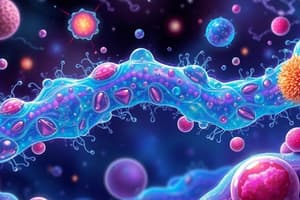Podcast
Questions and Answers
Which of the following best describes inorganic nutrients?
Which of the following best describes inorganic nutrients?
- Products of metabolic processes in organisms.
- Large complex structures made from living organisms.
- Atoms or simple molecules containing a combination of atoms other than carbon. (correct)
- Molecules primarily consisting of carbon and oxygen.
What characterizes organic nutrients in microbial nutrition?
What characterizes organic nutrients in microbial nutrition?
- They are exclusively composed of carbon without any hydrogen.
- They contain components primarily sourced from inorganic minerals.
- They include simple molecules and large polymers that contain carbon and hydrogen. (correct)
- They are produced solely by chemical reactions in non-living systems.
Which of the following statements accurately describes essential nutrients?
Which of the following statements accurately describes essential nutrients?
- They can be synthesized by the organism from simple raw materials.
- They must be provided externally as they are critical for growth. (correct)
- They are not necessary for the basic functions of the organism.
- They are only found in organic compounds derived from other organisms.
Which of the following is NOT considered an example of organic nutrients?
Which of the following is NOT considered an example of organic nutrients?
What is a distinguishing feature of inorganic nutrients in relation to their sources?
What is a distinguishing feature of inorganic nutrients in relation to their sources?
Which type of heterotroph derives nutrients from the cells or tissues of a living host?
Which type of heterotroph derives nutrients from the cells or tissues of a living host?
What type of interaction occurs when different species compete in a community for resources?
What type of interaction occurs when different species compete in a community for resources?
What is the main function of saprobes in the ecosystem?
What is the main function of saprobes in the ecosystem?
What is a crucial process used by bacteria in biofilms to communicate with each other?
What is a crucial process used by bacteria in biofilms to communicate with each other?
Which of the following nutrients is essential for stabilizing cell walls and endospores of bacteria?
Which of the following nutrients is essential for stabilizing cell walls and endospores of bacteria?
Which of the following best describes the structure of biofilms?
Which of the following best describes the structure of biofilms?
What defines a chemoheterotroph?
What defines a chemoheterotroph?
Which of the following describes intracellular parasites?
Which of the following describes intracellular parasites?
What method involves the complete elimination of all living cells, including viruses and spores?
What method involves the complete elimination of all living cells, including viruses and spores?
Which method reduces but does not eliminate all microorganisms on a surface?
Which method reduces but does not eliminate all microorganisms on a surface?
What is the primary characteristic of osmosis?
What is the primary characteristic of osmosis?
Which of the following best describes obligate parasites?
Which of the following best describes obligate parasites?
What is the role of the 'pioneer' colonizer in biofilm formation?
What is the role of the 'pioneer' colonizer in biofilm formation?
Which of the following does NOT typically describe antibiosis?
Which of the following does NOT typically describe antibiosis?
Which nutrient is a vital component of cytochrome proteins involved in cellular respiration?
Which nutrient is a vital component of cytochrome proteins involved in cellular respiration?
Which treatment aims to reduce microbial populations to public health standards?
Which treatment aims to reduce microbial populations to public health standards?
What is the primary distinction of active transport compared to passive transport?
What is the primary distinction of active transport compared to passive transport?
Which type of symbiotic relationship is characterized by one organism benefiting while the other is neither helped nor harmed?
Which type of symbiotic relationship is characterized by one organism benefiting while the other is neither helped nor harmed?
In what way do monosaccharides and amino acids relate to transport mechanisms across membranes?
In what way do monosaccharides and amino acids relate to transport mechanisms across membranes?
Which statement best describes the characteristic of mutualism?
Which statement best describes the characteristic of mutualism?
How would you define parasitism in the context of symbiotic relationships?
How would you define parasitism in the context of symbiotic relationships?
What does the term 'synergism' refer to in biological interactions?
What does the term 'synergism' refer to in biological interactions?
Which of the following interactions is deemed 'obligatory'?
Which of the following interactions is deemed 'obligatory'?
Which statement correctly contrasts the energy requirements of active and passive transport?
Which statement correctly contrasts the energy requirements of active and passive transport?
What is the primary purpose of using germicides?
What is the primary purpose of using germicides?
Which physical method is NOT effective in controlling microbial growth?
Which physical method is NOT effective in controlling microbial growth?
What does the Thermal Death Point (TDP) refer to?
What does the Thermal Death Point (TDP) refer to?
What is the purpose of decimal reduction time (DRT)?
What is the purpose of decimal reduction time (DRT)?
In microbial control, which term describes an agent that inhibits bacterial growth without killing them?
In microbial control, which term describes an agent that inhibits bacterial growth without killing them?
Which of the following is a downside of using heat as a method for microbial control?
Which of the following is a downside of using heat as a method for microbial control?
Which method of microbial control involves the removal of microbes from a specific area?
Which method of microbial control involves the removal of microbes from a specific area?
What is the main role of antiseptics in microbial control?
What is the main role of antiseptics in microbial control?
Which of the following methods is primarily used for food preservation by removing water from microbes?
Which of the following methods is primarily used for food preservation by removing water from microbes?
What is the principle behind the operation of HEPA filters?
What is the principle behind the operation of HEPA filters?
Which of the following statements about pasteurization is correct?
Which of the following statements about pasteurization is correct?
What temperature and duration is typically required for hot air sterilization to be effective?
What temperature and duration is typically required for hot air sterilization to be effective?
What is the primary use of freeze-drying (lyophilization) in food processing?
What is the primary use of freeze-drying (lyophilization) in food processing?
Which of the following methods is NOT effective against spores and viruses?
Which of the following methods is NOT effective against spores and viruses?
In what setting would you most likely find the application of HEPA filters?
In what setting would you most likely find the application of HEPA filters?
Which statement about ionizing radiation is true?
Which statement about ionizing radiation is true?
Flashcards
Essential Nutrient
Essential Nutrient
A substance that a microbe absolutely needs for growth and cannot make itself.
Inorganic Nutrient
Inorganic Nutrient
Atoms or simple molecules containing atoms other than carbon, found in the earth's crust, water, and the atmosphere.
Organic Nutrient
Organic Nutrient
Molecules containing carbon and hydrogen, produced by living organisms.
What is a nutrient?
What is a nutrient?
Signup and view all the flashcards
Microbial Nutrition
Microbial Nutrition
Signup and view all the flashcards
Chemoheterotrophs
Chemoheterotrophs
Signup and view all the flashcards
Parasites
Parasites
Signup and view all the flashcards
Ectoparasites
Ectoparasites
Signup and view all the flashcards
Endoparasites
Endoparasites
Signup and view all the flashcards
Intracellular parasites
Intracellular parasites
Signup and view all the flashcards
Obligate parasites
Obligate parasites
Signup and view all the flashcards
Osmosis
Osmosis
Signup and view all the flashcards
Selectively Permeable Membrane
Selectively Permeable Membrane
Signup and view all the flashcards
Active Transport
Active Transport
Signup and view all the flashcards
Passive Transport
Passive Transport
Signup and view all the flashcards
Symbiosis
Symbiosis
Signup and view all the flashcards
Mutualism
Mutualism
Signup and view all the flashcards
Commensalism
Commensalism
Signup and view all the flashcards
Synergism
Synergism
Signup and view all the flashcards
Substances Transported Actively
Substances Transported Actively
Signup and view all the flashcards
Antagonism
Antagonism
Signup and view all the flashcards
Antibiosis
Antibiosis
Signup and view all the flashcards
Biofilm
Biofilm
Signup and view all the flashcards
Quorum sensing
Quorum sensing
Signup and view all the flashcards
Sterilization
Sterilization
Signup and view all the flashcards
Disinfection
Disinfection
Signup and view all the flashcards
Sanitation
Sanitation
Signup and view all the flashcards
Biofilm structure
Biofilm structure
Signup and view all the flashcards
Microbial Control
Microbial Control
Signup and view all the flashcards
Antimicrobial Agent
Antimicrobial Agent
Signup and view all the flashcards
Antiseptic
Antiseptic
Signup and view all the flashcards
Germicide
Germicide
Signup and view all the flashcards
Bacteriostatic
Bacteriostatic
Signup and view all the flashcards
Degerming
Degerming
Signup and view all the flashcards
Thermal Death Point (TDP)
Thermal Death Point (TDP)
Signup and view all the flashcards
Decimal Reduction Time (DRT)
Decimal Reduction Time (DRT)
Signup and view all the flashcards
Pasteurization
Pasteurization
Signup and view all the flashcards
Dry Heat Sterilization
Dry Heat Sterilization
Signup and view all the flashcards
HEPA Filter
HEPA Filter
Signup and view all the flashcards
Filtration
Filtration
Signup and view all the flashcards
Desiccation
Desiccation
Signup and view all the flashcards
Radiation
Radiation
Signup and view all the flashcards
Ionizing Radiation
Ionizing Radiation
Signup and view all the flashcards
Study Notes
Microbial Nutrition
- Essential nutrient: A substance an organism must receive.
- Macronutrients: Needed in large quantities for cell structure and metabolism (carbon, hydrogen, oxygen).
- Micronutrients (trace elements): Needed in smaller amounts for enzyme function and protein structure (e.g., manganese, zinc, nickel).
- Inorganic nutrients: Atoms or molecules without carbon (found in Earth's crust, water, atmosphere).
- Organic nutrients: Contain carbon and hydrogen atoms, products of living things (simple organic molecules like methane, large polymers like carbohydrates, lipids, proteins, nucleic acids).
Chemical Analysis of the Microbial Cytoplasm
- Water: 70% of all cell components.
- Proteins: 97% of dry cell weight.
- Organic compounds: 97% of dry cell weight.
- Elements (CHONPS): 96% of dry cell weight.
- Few nutrient types synthesize over 5,000 compounds.
What Microbes Eat
- Heterotrophs: Obtain their carbon from organic substances.
- Autotrophs: Use inorganic CO₂ as their carbon source. Not nutritionally dependent on other living organisms.
- Phototrophs: Obtain energy from sunlight.
- Chemotrophs: Obtain energy from chemical compounds.
- Chemoheterotrophs: Obtain energy and carbon from organic compounds.
- Saprobes: Free-living organisms that feed on organic detritus from dead organisms. Recyclers of inorganic nutrients.
- Parasites: Obtain nutrients from the cells or tissues of a living host and often cause harm.
Autotrophs and their Energy Sources
- Photoautotrophs: Photosynthesize, using CO₂. (algae, plants, cyanobacteria).
- Chemoautotrophs: Use inorganic compounds as an energy source, and CO₂ as the carbon source. (methanogens, deep-sea vent bacteria).
Microbial Interactions
- Microbes usually live in shared habitats.
- Interactions can be beneficial, harmful, or neutral.
- Obligatory or non-obligatory to the members.
- Nutritional interactions are common.
Strong Partnerships: Symbioses
- Symbiosis: A close partnership between organisms.
- Mutualism: Both organisms benefit.
- Commensalism: One organism benefits, the other is unaffected.
- Parasitism: One organism benefits, the other is harmed.
Associations But Not Partnerships
- Synergism: Two or more organisms benefit, though no one is completely dependent on another. Beneficial interaction without dependence.
- Antagonism: One species competes, sometimes inhibiting growth of the other, sometimes producing harmful compounds.
- Biofilms: Mixed communities attached to surfaces that often work together in complex interactions.
How Microbes Eat: Transport Mechanisms
- Transport mechanisms: Drive nutrients across cell membranes.
- Diffusion: Movement of molecules from high to low concentration.
- Active transport: Movement of molecules from low to high concentration, requiring energy (e.g., ATP).
Methods to control microbial growth
- Sterilization: Completely eliminates all forms of life.
- Disinfection: Eliminates most microorganisms but not necessarily all.
- Sanitation: Reduces microbial levels to safe, public health levels.
- Physical methods: Heat, desiccation, osmotic pressure, filtration, radiation.
- Chemical methods: Phenols, halogens, alcohols, heavy metals, surface-active agents, organic acids, aldehydes, antimicrobials.
Additional Physical Methods of Microbial Growth Control
- Heat: High temperatures denature enzymes, kill microorganisms. (Thermal Death Point (TDP), Thermal Death Time (TDT), Decimal Reduction Time (DRT)).
- Desiccation: Removal of water inhibits growth
- Osmotic Pressure: High salt or sugar concentrations cause water loss from cells.
- Filtration: Removal of microbes by physical barriers with small pores.
- Radiation: Damaging DNA and other biological structures. (Ionizing, Non-ionizing).
Additional Chemical Methods of Control
- Phenols and phenolics: Damage cell components.
- Halogens (iodine, chlorine): Often alter enzymes or disrupt cellular functions .
- Alcohols: Denature proteins and dissolve lipids, evaporates quickly.
- Heavy Metals: Denature proteins, prevent microbial growth.
- Surface-active agents: (soaps, detergents) disrupt cell membranes.
- Organic acids: Inhibit the growth of certain microorganisms.
- Aldehydes: Inactivate proteins, used for sterilizing instruments.
- Antibiotics: Kill or inhibit growth of microbes.
Methods of Microbial Control: Autoclaving, Pasteurization, Low Temperatures
- Autoclaving: A method of sterilization. Uses steam under pressure. Eliminates all microorganisms.
- Pasteurization: Reduces microbial load, usually for food. Does not completely sterilize. (e.g., milk pasteurization, beer preservation).
- Low Temperatures: Slows microbial growth, does not necessarily kill them, often used for food preservation.
Methods of Microbial Control: Drying, Filtration, and Radiation
- Desiccation (drying): Removes moisture and inhibits growth.
- Filtration: Removes microbes through a filter which is physically blocking them, usually used to sterilize solutions that cannot be heated.
- Radiation: Damages DNA or proteins, often used to sterilize or disinfect. Two main types are ionizing and non-ionizing radiation.
Microbial Control: Types, Techniques, and Application
- Dry heat sterilization: Inactivates heat-resistant microbes using high temperatures, usually with air, and can sterilize objects that cannot be exposed to steam.
- Direct flaming: Sterilizes loops in microbiological work in a very precise way.
- HEPA filters: Removes microbes and other small particles from an air supply.
- Osmotic pressure: High salt or sugar concentrations cause water loss from cells (preserves food).
Studying That Suits You
Use AI to generate personalized quizzes and flashcards to suit your learning preferences.




